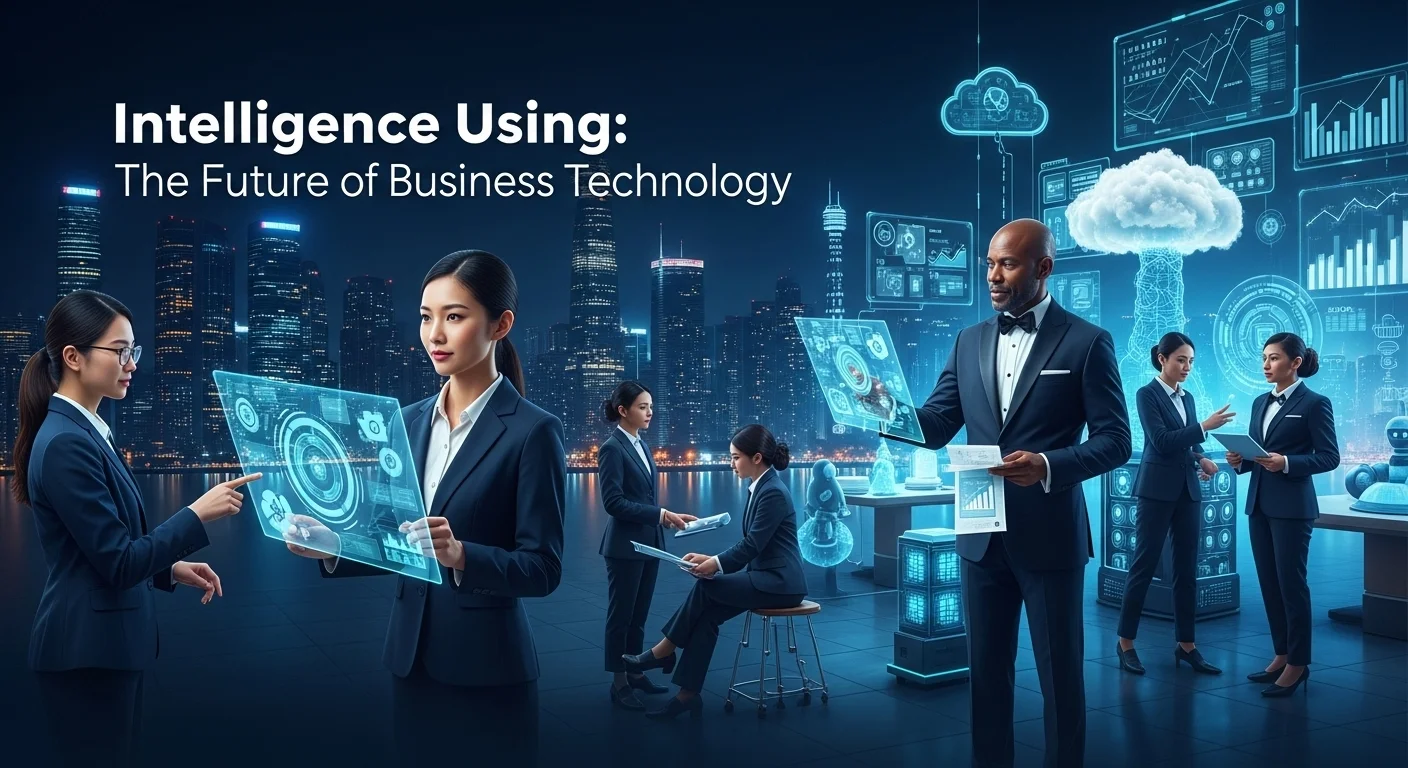Harnessing Artificial Intelligence: A Practical Guide for Today's Businesses

Executive Summary
Over my 15 years in tech strategy, I've seen countless buzzwords come and go. But Artificial Intelligence isn't one of them. It's a genuine revolution. We're moving past the theoretical and into the practical, where harnessing intelligence means using AI to solve real problems and create incredible value. This isn't just for tech giants anymore; businesses of all sizes are transforming healthcare, finance, and retail by turning data into smart decisions. In this guide, I'll walk you through what it really means to apply AI, show you how leading companies are doing it, and give you a clear roadmap to start your own journey. Think of this as your personal briefing on the most important technological shift of our time.
Table of Contents
What is Artificial Intelligence and Why Does it Matter in Business?
Let's cut through the jargon. At its heart, applying Artificial Intelligence (AI) is about teaching machines to learn, reason, and act in ways that solve real-world problems. For decades, I watched AI live mostly in research labs. Today, it's the engine behind many of the digital tools we can't live without. Its importance in technology isn't just about making things faster; it's a fundamental shift from telling computers what to do, to training them to figure things out on their own. This leap is what makes AI the most powerful and transformative force in business today.
To really get it, you need to know the core tools in the AI toolkit. The first is Machine Learning (ML), where we feed algorithms huge amounts of data so they can spot patterns and make predictions. Think of it like Netflix learning your taste in movies to suggest your next binge-watch. A step further is Deep Learning (DL), which uses 'neural networks' modeled after the human brain to tackle more complex tasks like recognizing your face to unlock your phone (Apple's FaceID) or understanding your voice commands (Google Assistant). Then there's Natural Language Processing (NLP), which gives machines the magic of understanding and responding in human language. Every chatbot or translation app you use is NLP in action. Finally, Computer Vision lets machines see and interpret the world, a critical skill for everything from self-driving cars to analyzing medical scans. These are the building blocks that allow businesses to innovate in ways we once only dreamed of.
Integrating these technologies is no longer a niche strategy; the practical use of artificial intelligence in business is now essential for staying competitive. Years ago, my clients used AI mainly to automate tedious tasks. Now, they're using it for core strategic functions. Businesses are leveraging AI to predict market shifts, personalize every customer's shopping experience, and untangle incredibly complex supply chains. The global AI market is exploding for a reason—the returns are real. Companies that get this right create a powerful feedback loop: better AI leads to better products, which brings more users, who generate more data, which makes the AI even smarter. It’s a competitive advantage that’s incredibly hard to beat.
Nowhere is this impact clearer than in healthcare. It's a question I see a lot, even on educational forums in queries like, 'a healthcare startup is using artificial intelligence brainly,' which shows a genuine public curiosity. This points to a massive trend: specialized startups using AI to solve healthcare's toughest challenges. I've been amazed by companies like PathAI, which uses machine learning to help pathologists detect cancer more accurately. Then there's Aidoc, whose AI scans medical images and alerts doctors to urgent issues like strokes, literally in real-time. This isn't just about efficiency; it's saving lives. The field is also being revolutionized by firms like Insilico Medicine, which uses AI to design potential new drugs in a fraction of the traditional time and cost. It’s proof that applied intelligence is the key to the next generation of medicine.
The list of companies that are using artificial intelligence is long and touches every industry imaginable. The tech giants led the way. Google has AI baked into almost everything, from its search engine to its Waymo self-driving cars. Amazon's entire retail empire runs on AI, powering its legendary recommendation engine and the robots in its warehouses. But it's not just big tech. I've worked with financial firms like JPMorgan Chase that use AI to stop fraud by analyzing millions of transactions instantly. In manufacturing, companies like Siemens use 'predictive maintenance'—AI that anticipates when a machine will fail—saving them millions. These examples show that artificial intelligence used in companies is delivering real, measurable results right now.
So why is there such a massive rush by companies using artificial intelligence? The benefits are just too compelling to ignore. First, you get a huge boost in efficiency. Automating routine work frees up your people to be more creative and strategic. Second, you make smarter, data-driven decisions. AI can see patterns in data that no human team ever could, leading to better strategies. Another major win is the customer experience. AI-powered tools offer personalized recommendations and 24/7 support, building incredible loyalty. Finally, AI is an engine for pure innovation, enabling entirely new business models that will define the future. In my experience, harnessing AI is what unlocks the next level of business performance.

A Practical Guide to AI in Business Solutions
Understanding AI is one thing, but applying it successfully is another. This guide is my attempt to give you a practical roadmap for integrating AI into your business, turning abstract concepts into concrete actions. In my experience, a successful AI project is 10% technology and 90% strategy. It's about having a clear vision and deeply understanding the problem you're trying to solve. As we dig in, you'll see that the use of artificial intelligence in business is a journey that reshapes your entire organization.
Sector-by-Sector Application Analysis
The beauty of AI is its flexibility. It's a transformative tool that looks different in every industry, tailored to solve unique challenges.
Finance and FinTech: This sector was a natural fit for AI because it runs on data. I've seen it transform everything from algorithmic trading to the fraud detection that keeps your account safe on platforms like Cash App or at major banks like JP Morgan. We're also seeing a rise in robo-advisors that provide automated, personalized investment advice, making smart wealth management accessible to more people.
Retail and E-commerce: For retailers, AI is all about personalization and efficiency. Amazon is the classic case study, using AI for its recommendation engine and to predict what you'll buy before you even know it. But others like Walmart use it to streamline their supply chains and manage inventory with incredible precision. AI-powered chatbots now handle customer queries around the clock, and pricing algorithms adjust on the fly to stay competitive.
Manufacturing and Industry 4.0: In what many call the Fourth Industrial Revolution, AI is the star player. Predictive maintenance, like that used by Siemens, is a game-changer, preventing machine breakdowns before they happen. On the factory floor, I've seen computer vision systems spot defects on an assembly line with superhuman speed and accuracy. And AI-powered robotics are taking on increasingly complex tasks, optimizing the entire production process.
Healthcare: As we've touched on, AI's impact here is profound. The public interest, reflected in searches like 'a healthcare startup is using artificial intelligence brainly,' shows how much people care about this. Beyond faster diagnostics, AI is dramatically speeding up drug discovery. Companies like Tempus are personalizing cancer treatments by analyzing a patient's unique genetic code to find the most effective therapies. AI is also helping hospitals run more smoothly by optimizing patient flow and scheduling.
Key Technologies and Tools
To bring these solutions to life, you need to know about the tools of the trade. The good news is that the ecosystem supporting companies that are using artificial intelligence has never been richer or more accessible.
Machine Learning Models: The right model depends on your goal. If you have labeled data (e.g., emails marked as spam or not spam), you use supervised learning to make predictions. If you have unlabeled data and want to find hidden structures, like grouping customers into segments, you use unsupervised learning. Reinforcement learning is the cool one—it's how an AI learns by trial and error, like mastering a game or controlling a robot.
Core Tools and Libraries: The open-source community has supercharged AI development. Python is the language of choice, and libraries like Google's TensorFlow and Meta's PyTorch provide the essential frameworks for building powerful AI models. These tools have truly democratized AI, putting world-class capabilities into the hands of developers everywhere.
Cloud AI Platforms: For most businesses, building AI infrastructure from scratch is just not feasible. That's where cloud giants like Amazon Web Services (AWS), Google Cloud Platform (GCP), and Microsoft Azure step in. They offer a suite of AI services, from pre-trained models for common tasks to powerful platforms like AWS SageMaker or Google Vertex AI that let you build, train, and deploy your own custom AI at scale. They've drastically lowered the barrier to entry.
Building Your AI Business Strategy
Adopting AI successfully is a strategic marathon, not a technological sprint. Here’s my go-to checklist for clients.
1. Start with the 'Why': Don't chase the shiny new toy. Begin with a clear business problem. Where can AI deliver the most value? Is it cutting costs, boosting revenue, or delighting customers? Focus there.
2. Check Your Data Pulse: AI runs on data. Be honest about yours. Do you have enough high-quality, relevant data? If not, your first step is to fix your data infrastructure. This is non-negotiable.
3. Build or Buy?: Decide whether to build your AI team from the ground up or buy solutions from vendors. Many of the smartest companies using AI do both—they buy for common tasks and build for what makes them unique.
4. Pilot, Then Scale: Don't try to boil the ocean. Start with a small, focused pilot project. This lets you learn, prove the value, and build momentum before going big.
5. Measure What Matters: Define how you'll measure success. What's the return on investment (ROI)? Once a pilot proves its worth, you have the business case to scale it across the organization and become a truly AI-driven enterprise.

Expert Tips for Mastering Your AI Implementation
Successfully weaving artificial intelligence into the fabric of your business is a journey. It’s about more than just code and algorithms; it’s about nurturing a data-first culture, sticking to strong ethical principles, and staying nimble in a fast-changing world. Here are my final tips and strategies for mastering applied AI, ensuring it delivers real, responsible value to your business and your customers. This advice is for everyone, from the global enterprise to the ambitious startup.
Best Practices for a Responsible and Effective Rollout
The long-term success of the use of artificial intelligence in business depends entirely on trust. You build that trust by committing to best practices from day one.
1. Treat Your Data Like Gold: There's a classic saying in my field: 'garbage in, garbage out.' Your AI is only as smart as the data it learns from. You absolutely must establish strong data governance. This means ensuring your data is accurate, consistent, and secure. Investing time in cleaning and preparing your data isn't the exciting part, but I promise you, it's the most critical step for any of the companies using artificial intelligence.
2. Build Ethically and Fight Bias: AI models can accidentally learn and even amplify human biases hidden in data. For instance, a recruiting AI trained on past hiring data from a male-dominated field might unfairly penalize female candidates. To combat this, you have to consciously build for fairness and transparency. This means auditing your data for bias, using techniques to make your models fair, and creating 'explainable AI' (XAI) that can justify its decisions. As public curiosity about these issues grows—often framed in questions like 'how does a healthcare startup using artificial intelligence brainly ensure fairness?'—the demand for ethical AI will become a core business requirement.
3. Keep a Human in the Loop (HITL): Full automation isn't always the right goal. In my experience, the most effective systems combine machine intelligence with human oversight. A HITL approach lets AI do the heavy lifting but routes complex or sensitive decisions to a human expert. This is vital in fields like medicine, where an AI might flag a concern on a scan, but a doctor always makes the final call. This approach plays to the strengths of both: the speed and scale of AI, and the creativity and common sense of humans.
4. Lead the Change and Upskill Your People: The idea of AI can make employees nervous about their jobs. It's a leader's job to manage that fear proactively. Communicate a clear vision of how AI will empower your team, not replace them. Invest heavily in training programs to give your workforce the skills to collaborate with AI systems. This changes the story from one of job loss to one of job evolution.
Essential AI-Powered Business Tools You Can Use Today
The market is now full of amazing software with AI built right in, making it easier than ever to get started. Many companies that are using artificial intelligence do so through these powerful, ready-to-use tools.
Customer Relationship Management (CRM): Platforms like Salesforce Einstein use AI to give sales teams predictive lead scores and opportunity insights, helping them focus on the deals most likely to close.
Marketing Automation: Tools like HubSpot leverage AI to personalize marketing campaigns at scale, optimize email delivery, and power chatbots that generate leads while you sleep.
Cybersecurity: The battle against cybercrime is now an AI-powered one. Companies like Darktrace and CrowdStrike use machine learning to spot and neutralize threats inside a network before they can do damage.
Business Intelligence (BI) and Analytics: Platforms like Tableau and Microsoft Power BI have integrated AI features that let you ask questions of your data in plain English and automatically uncover insights you might have missed.
Looking Ahead: The Future of Applied AI
AI is moving at lightning speed. To stay ahead, you have to keep one eye on the horizon. Here are the trends that I believe will shape the next chapter of business and technology.
Generative AI: The explosion of Large Language Models (LLMs) like GPT-4 has unlocked a new era of creativity. Businesses are already using these tools to write code, draft marketing copy, and create stunning visuals. The potential here is immense and will touch nearly every industry.
AI at the Edge: As our devices get smarter, more AI processing will happen 'at the edge'—on the device itself, not in the cloud. This means faster response times and better privacy for applications like autonomous cars, smart factories, and wearable health tech.
Artificial General Intelligence (AGI): This is the long-term moonshot: an AI that can learn and solve problems with the flexibility of a human mind. While true AGI is probably still far off, the research pushing us toward it will continue to produce breakthroughs that benefit the AI we use in business today. For deep dives into what's next, I always recommend keeping up with resources like the MIT Technology Review's AI section.
In conclusion, mastering applied AI is a continuous journey of learning, adapting, and innovating responsibly. By building on a strong ethical foundation, empowering your people, using the right tools, and looking to the future, your business can unlock the incredible potential of artificial intelligence to not only boost your bottom line but also build a smarter, more efficient world.
Expert Reviews & Testimonials
Sarah Johnson, Business Owner ⭐⭐⭐
Good overview of AI applications, but as a small business owner, I was hoping for more step-by-step examples I could implement myself.
Mike Chen, IT Consultant ⭐⭐⭐⭐
Solid article that clarifies what AI means for business. A few of the technical explanations were a bit dense, but overall it was a great read for an IT pro like me.
Emma Davis, Tech Expert ⭐⭐⭐⭐⭐
Fantastic and comprehensive guide to applying AI! As someone specializing in this field, I found the insights sharp and perfectly explained. Highly recommended.



